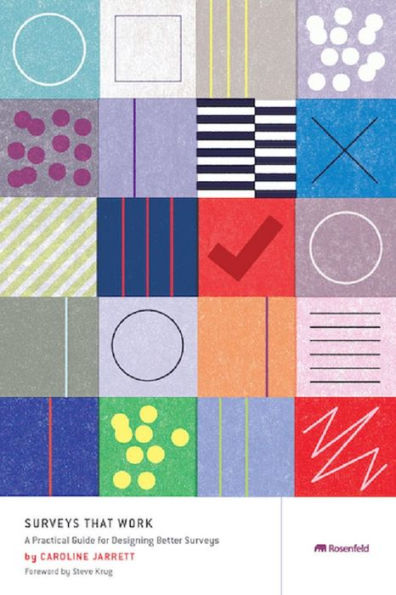
Surveys That Work: A Practical Guide for Designing and Running Better Surveys
368
Surveys That Work: A Practical Guide for Designing and Running Better Surveys
368Paperback
-
PICK UP IN STORECheck Availability at Nearby Stores
Available within 2 business hours
Related collections and offers
Overview

Product Details
| ISBN-13: | 9781933820538 |
|---|---|
| Publisher: | Rosenfeld Media |
| Publication date: | 08/17/2021 |
| Pages: | 368 |
| Sales rank: | 219,268 |
| Product dimensions: | 6.00(w) x 9.00(h) x (d) |
About the Author
Caroline has an MA in Mathematics from Oxford University, an MBA and a Diploma in Statistics from the Open University, and is a Chartered Engineer. Caroline is co–author of Forms that Work: Designing Web Forms for Usability (Morgan Kaufmann/Elsevier) and of User Interface Design and Evaluation (The Open University/Elsevier).
Caroline's website is Effortmark.co.uk. Find her on Twitter as @cjforms.
Table of Contents
How to Use This Book vi
Frequently Asked Questions vii
Foreword xiii
Introduction xvii
Definitions What is a Survey? And the Survey Octopus 1
A survey is a process 2
Total Survey Error focuses on reducing problems overall 4
Meet the Survey Octopus 5
We'll aim for Light Touch Surveys 8
Spotlight A Four Different Types of Surveys 13
Chapter 1 Goals: Establish Your Goals for the Survey 19
Write down all your questions 21
Choose the Most Crucial Question (MCQ) 24
Check that a survey is the right thing to do 26
Determine the time you have and the help you need 33
What could possibly go wrong with the goals? 35
At this point, you will know 36
Spotlight B The Net Promoter Score® and Correlation 37
Spotlight C Satisfaction 43
Chapter 2 Sample: Find People Who Will Answer 51
Some of the people you ask will decide not to answer 52
Response rates vary by the way you deliver your questionnaire 53
Response depends on trust, effort, and reward 54
Decide how many answers you need 62
Find the people who you want to ask 67
The right response is better than a big response 76
What can possibly go wrong with sampling? 83
At this point, you will know 86
Spotlight D Statistical Significance 87
Chapter 3 Questions: Write and Test the Questions 97
Understand the four steps to answer a question 98
Good questions are easy to understand 100
Good questions ask for answers that are easy to find 103
Good questions are comfortable to answer 110
Good questionnaires make it easy to respond 117
Test your questions in cognitive interviews 118
What could possibly go wrong with the questions? 120
At this point, you will know 122
Spotlight E Privacy 123
Spotlight F Question to Ask When You Choose a Survey Tool 129
Spotlight G Choose Your Mode: Web, Paper, or Something Else? 141
Chapter 4 Questionnaire: Build and Test the Questionnaire 153
What could possibly go wrong with your questionnaire? 154
Good questions are easy to respond to 155
Choose your images carefully 170
Consider the order of your questions 179
Test your questionnaire 187
Take screenshots of your final questionnaire 191
At this point, you will know 192
Spotlight H "On a Scale from 1 to 5" (Likert and Rating Scales) 193
Chapter 5 Decide on your invitation, thank-you, and follow-up 218
Do a pilot test 227
Launch your fieldwork and look after it 229
What could possibly go wrong with fieldwork? 231
At this point, you will know 231
Chapter 6 Clean your data 239
Decide whose responses you will use 247
Get to know your numeric data 251
Look for themes in your open answers: Coding 261
What could possibly go wrong with responses? 272
At this point, you will know 273
Spotlight I A Good Chart IS Easy to Read and Honest 275
Chapter 7 Reports: Show the Results to Decision-Makers 285
Think about what you learned, numerically 286
Decide what news to deliver and when 288
Decide what format to use for delivery 291
Choose "inverted pyramid" for most presentations 294
There are many ways of showing the same results 295
The best insights come from using surveys alongside other methods 301
What could possibly go wrong with reports? 304
At this point, you will know 306
Chapter 8 The Least You Can Do™ 309
The survey process has seven steps 310
What to do when you've only got an hour 311
What to do when you've got a day 312
What to do when you've got a whole week 313
The checklist for everything 315
The final word is "iterate" 319
Index 321
Reference 338
Acknowledgments 343
About the Author 348
